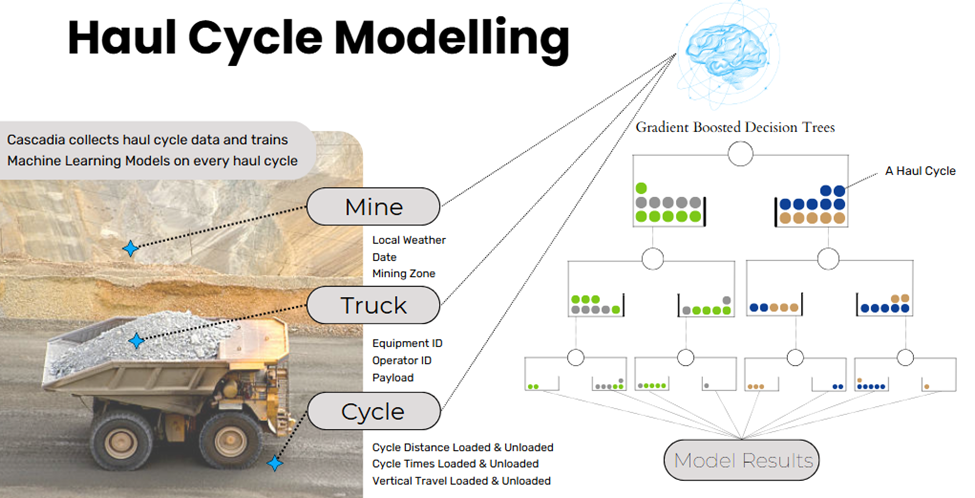From Data Deluge to Decisive Action
Mining is no longer just about moving rock, it’s about moving data. Every haul truck, shovel, and dozer generates streams of information: engine health, fuel use, tire wear, idle time, road conditions, operator inputs, and more. In fact, a modern mine can collect gigabytes of data per day. This flood of information is both a blessing and a burden. On one hand, it promises insights that could cut costs, improve safety, and reduce emissions. On the other hand, the sheer scale of the data can feel overwhelming.
A lot of mines are asking:
- What do we actually do with all this data?
- Is “machine learning” just another buzzword?
- Will it take away jobs, or make mine sites too complicated to manage?
The reality is that machine learning (ML) isn’t about replacing miners; it’s about equipping them with better tools. Done right, it makes mining more productive, safer, and more sustainable, without adding complexity or sidelining human expertise.
Why Machine Learning Matters Now
The pressures facing today’s mines are heavier than ever:
- Rising costs: Fuel and maintenance eat a huge share of budgets.
- Aging fleets: Keeping equipment running longer without constant downtime.
- Environmental goals: Meeting tough ESG targets while maintaining productivity.
Traditional tools, spreadsheets, averages, and after-the-fact reports can’t keep up. They typically show what happened yesterday. But in mining, the real value lies in knowing what’s happening now and predicting what will happen next. That’s where machine learning comes in.

How Machine Learning Works in Mining (Plain and Simple)
At its core, machine learning is about teaching computers to spot patterns in complex data that humans often overlook. Think of it as having an assistant who never sleeps, constantly analyzing millions of data points from your site and highlighting exactly what matters, and what you need to be aware of.

Dr. Ali Soofastaei
Cascadia Scientific Performance Assurance Manager – Australia

Here’s an example:
Operator Performance
Comparing operators is tricky. One might drive an older truck on steep grades, while another works shorter, easier routes. Simple averages won’t tell you who’s actually more efficient.
ML models can account for dozens of factors, payload, grade, distance, idle time, shift length, even weather, and isolate the operator’s impact. This means you can see, fairly and accurately, how different driving styles affect fuel use and productivity.
Predicting Failures Before They Happen
Instead of waiting for a part to fail, ML can detect subtle signals in fuel flow, temperature, or vibration data that suggest a component is starting to wear out. Maintenance teams can act before a breakdown occurs, avoiding costly downtime.
Smarter Refueling
Most mines refuel trucks with a third of the tank still full, wasting valuable time. ML uses real-time fuel burn data, combined with operating conditions, to safely extend time between refuels, keeping trucks hauling longer and reducing fuel-out risks.
Road Condition Insights
By linking GPS data with fuel consumption and vibration patterns, ML models can flag sections of road that are eating more fuel and wearing down equipment. Fixing these hotspots can cut fuel use by 5–15%.
What Machine Learning Actually Solves
For miners, the value of ML comes down to three clear benefits:
- Efficiency: More tons moved per hour, less fuel burned per cycle.
- Maintenance: Fewer breakdowns and safer haul routes.
- Sustainability: Lower emissions, helping meet ESG targets without reducing production.
It’s not about handing control to machines. It’s about giving miners better visibility, turning endless rows of data into clear, actionable insights.
The Bottom Line
Machine learning isn’t some distant future. It’s here, and it’s already changing how mines operate. It’s not about complexity or replacing people; it’s about making decisions clearer, faster, and more effective.
For miners, that means:
- Less wasted time and fuel
- Optimised haul roads
- More reliable equipment
- Real progress on sustainability goals
In short, machine learning turns today’s data into tomorrow’s competitive advantage.


